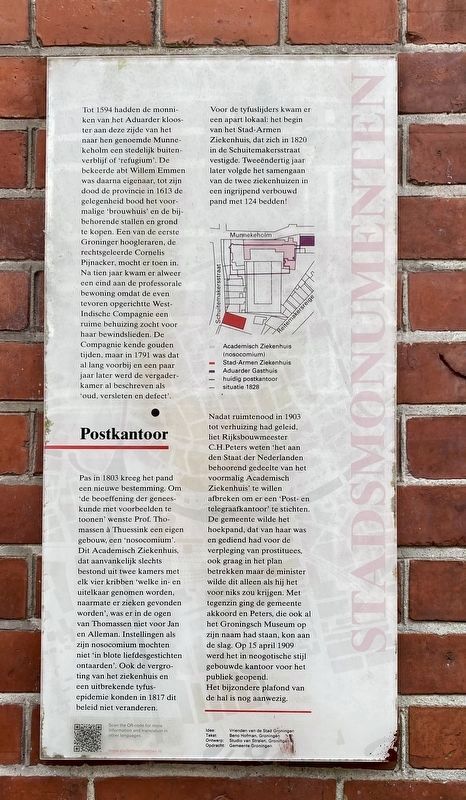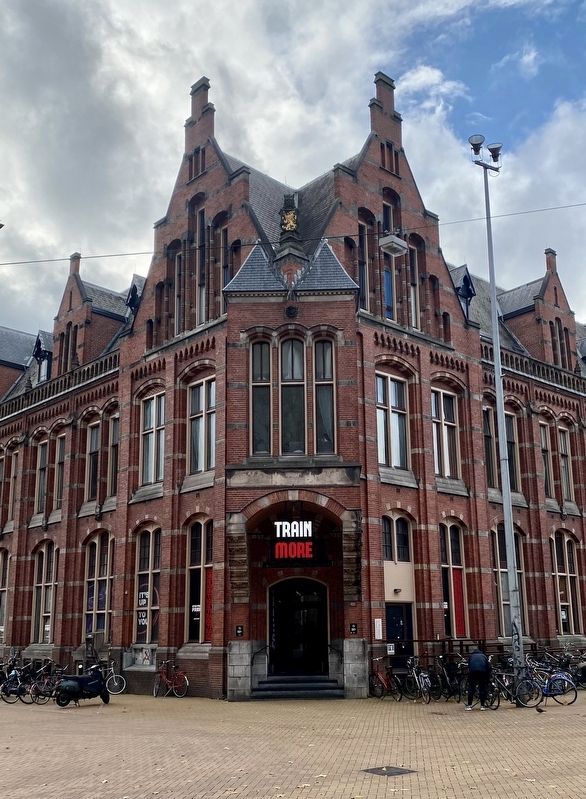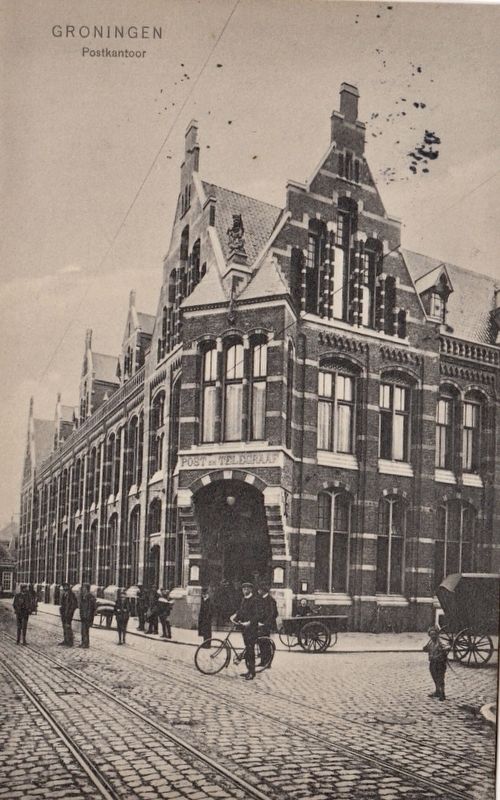Groningen, Netherlands — Northwestern Europe
Postkantoor/ Post Office
— Stadsmonumenten —
Tot 1594 hadden de monniken van het Aduarder klooster aan deze zijde van het naar hen genoemde Munnekeholm een stedelijk buitenverblijf of ‘refugium’. De bekeerde abt Willem Emmen was daarna eigenaar, tot zijn dood de provincie in 1613 de gelegenheid bood het voormalige ‘brouwhuis’ en de bijbehorende stallen en grond te kopen. Een van de eerste Groninger hoogleraren, de rechtsgeleerde Cornelis Pijnacker, mocht er toen in. Na tien jaar kwam er alweer een eind aan de professorale bewoning omdat de even tevoren opgerichte West-Indische Compagnie een ruime behuizing zocht voor haar bewindslieden. De Compagnie kende gouden tijden, maar in 1791 was dat al lang voorbij en een paar jaar later werd de vergaderkamer al beschreven als ‘oud, versleten en defect’.
Pas in 1803 kreeg het pand een nieuwe bestemming. Om ‘de beoefening der geneeskunde met voorbeelden te toonen’ wenste Prof. Thomassen à Thuessink een eigen gebouw, een ‘nosocomium’. Dit Academisch Ziekenhuis, dat aanvankelijk slechts bestond uit twee kamers met elk vier kribben ‘welke in- en uit elkaar genomen worden, naarmate er zieken gevonden worden’, was er in de ogen van Thomassen niet voor Jan en Alleman. Instellingen als zijn nosocomium mochten niet ‘in blote liefdesgestichten ontaarden’. Ook de vergroting van het ziekenhuis en een uitbrekende tyfusepidemie konden in 1817 dit beleid niet veranderen. Voor de tyfuslijders kwam er een apart lokaal: het begin van het Stad-Armen Ziekenhuis, dat zich in 1820 in de Schuitemakersstraat vestigde. Tweeëndertig jaar later volgde het samengaan van de twee ziekenhuizen in een ingrijpend verbouwd pand met 124 bedden!
Nadat ruimtenood in 1903 tot verhuizing had geleid, liet Rijksbouwmeester C.H. Peters weten ‘het aan den Staat der Nederlanden behoorend gedeelte van het voormalig Academisch Ziekenhuis’ te willen afbreken om er een ‘Post- en telegraafkantoor’ te stichten. De gemeente wilde het hoekpand, dat van haar was en gediend had voor de verpleging van prostituees, ook graag in het plan betrekken maar de minister wilde dit alleen als hij het voor niks zou krijgen. Met tegenzin ging de gemeente akkoord en Peters, die ook al het Groningsch Museum op zijn naam had staan, kon aan de slag. Op 15 april 1909 werd het in neogotische stijl gebouwde kantoor voor het publiek geopend. Het bijzondere plafond van de hal is nog aanwezig.
Till 1594, the Monks of the Aduarder Monastery had on this side of Munnekeholm
- which was named after them- an urban retreat or “refugium”. The converted abbot Willem Emmen was the next owner and his death in 1613 allowed the province to buy the former “brewhouse” and corresponding stables. One of Groningen’s first professors, legal scholar Cornelis Pijnacker, was then allowed to stay there. This ended after just 10 years because a newly founded West Indian Company was looking for large living spaces for their executives. The Company went through golden times, but this was long gone in 1971 and a few years later the meeting room was already described as old, used-up and broken.
It took until 1803 that the building got a new destination. To show the “practice of medicine with examples” Professor Thomassen à Thuessink wished to have an own building, a “nosocomium”. This academic Hospital, which originally consisted of just two rooms with each four beds which could get ready when sick people were found, it was not meant for just anyone according to Thomassen. Institutions like his nosocomium were not intended for all out charity. Even the big expansion and the outbreak of a typhus epidemic in 1817 did not change this policy. For people with typhus came a separate area: the start of the Stad-Armen Hospital, which moved to the Schuitemakersstraat in 1820. Thirty-two years later the hospitals merged together in a massively reconstructed building with 124 beds!
After the lack of space caused the move in 1903, Government Architect C.H. Peters wanted to break down the “former Academic Hospital belonging to the State of the Netherlands” to establish a post and telegram office. The council wanted the corner building, that belonged to them and served as a nursing place for prostitutes, to also be included in the Minister's plan. But the minister only wanted this if he was to get it free of charge. With aversion, the council agreed to this and Peters, who also had the Gronigsch Museum written down in his name, could get started. On the 15th of April 1909, the in neo gothic style constructed office was open to the public. The remarkable sealing of the hallway is still present today.
Erected by Gemeente Groningen. (Marker Number 25.)
Topics and series. This historical marker is listed in these topic lists: Communications • Science & Medicine. In addition, it is included in the Groningen Stadsmonumenten series list. A significant historical date for this entry is April 15, 1909.
Location. 53° 12.956′ N, 6° 33.691′ E. Marker is in Groningen. Marker is on Munnekolm. Touch for map. Marker is at or near this postal address: Munnekolm 2, Groningen 9712 BC, Netherlands. Touch for directions.
Other nearby markers. At least 8 other markers are within walking distance of this marker. Evert Jan Thomassen à Thuessink (here, next to this marker); A-Kerk / A-Church (within shouting distance of this marker); Alida (about 90 meters away, measured in a direct line); Huis Eem (about 180 meters away); Oprichting van de Loge / Establishment of I.O.O.F. Lodge (about 180 meters away); Vereeniging van Groningen Handelaren / Groningen Merchants Association (1847 - 1992) (about 180 meters away); Korenbeurs / Grain Exchange (about 180 meters away); Sociaal Democratische Bond / Social Democratic Union (about 180 meters away). Touch for a list and map of all markers in Groningen.
Credits. This page was last revised on February 22, 2023. It was originally submitted on February 22, 2023, by Andrew Ruppenstein of Lamorinda, California. This page has been viewed 47 times since then and 6 times this year. Photos: 1, 2, 3. submitted on February 22, 2023, by Andrew Ruppenstein of Lamorinda, California.


